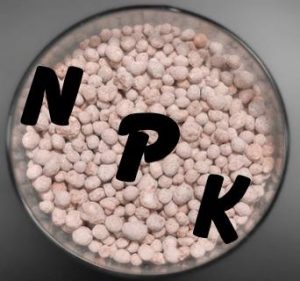Most compound fertilisers will contain three elements essential for growth, NPK which stands for Nitrogen (N) Phosphorus (P) and Potassium (K).
 These elements help plants grow in different ways. An understanding of this will help you when choosing the correct fertiliser for a plant or for a stage in the development of a plant.
These elements help plants grow in different ways. An understanding of this will help you when choosing the correct fertiliser for a plant or for a stage in the development of a plant.
When you buy a packaged commercial fertiliser you will see an analysis of the NPK content.
An equally balanced fertiliser may be described as 5:5:5 – 5% Nitrogen, 5% Phosphorus and 5% Potassium. You may also see Potassium described as Potash.
Nitrogen the N in NPK
Nitrogen is used by the plant to produce leafy growth and formation of stems and branches. Plants most in need of nitrogen include grasses and leafy vegetables such as cabbage and spinach. Basically, the more leaf a plant produces, the higher its nitrogen requirement. See nitrogen requirements of brassicas.
Although 78% of the atmosphere is nitrogen, most plants cannot utilise this. Plants in the bean family, legumes, have nodules on their roots where bacteria live that fix nitrogen from the air for use by the plant. They provide their own nitrogen fertiliser this way.
Shortage of Nitrogen in Plants – Symptoms
You can tell if your plants need nitrogen when their growth is stunted with weak stems and they will have yellowed or discoloured leaves
Application of Nitrogen
Nitrogenous fertilisers are quickly washed out of the soil by rain and need to be renewed annually. With crops that require a lot of nitrogen over a period of time, like cabbages, adding nitrogen incrementally through the growth period is the most efficient application method.
Phosphorus the P in NPK
Phosphorus is essential for seed germination and root development. It is needed particularly by young plants forming their root systems and by fruit and seed crops. Root vegetables such as carrots, swedes and turnips obviously need plentiful phosphorus to develop well.
Shortage of Phosphorus in Plants – Symptoms
Without ample phosphorus you will see stunted growth, probably a purple tinge to leaves and low fruit yields.
Application of Phosphorus
Phosphates remain in the soil for two or three years after application so the amount in a general fertilizer is probably enough. Add just before planting or top dress during growth periods.
Potassium the K in NPK
Potassium has the chemical symbol K from its Latin name kalium. It promotes flower and fruit production and is vital for maintaining growth and helping plants resist disease.
It’s used in the process of building starches and sugars so is needed in vegetables and fruits. Carrots, parsnips, potatoes, tomatoes and apples all need plenty of potassium to crop well.
Potassium is naturally found in wood ash which is where it its name potash is derived from To recap potash is potassium and vice versa when discussing fertilisers.
Shortage of Potassium in Plants – Symptoms
Plants that are short of potash will have low resistance to disease, scorching of leaves and poor fruit yield. Tomatoes will really show the effects of a shortage of potassium
Application of Potassium
Potash usually last for two or three years in the soil but for vegetable production (tomatoes, potatoes especially) additional will be required.
This can be applied as a liquid feed, either commercial or made from comfrey as comfrey tea, for tomatoes or a specially prepared fertiliser, high in potassium for potatoes.



